
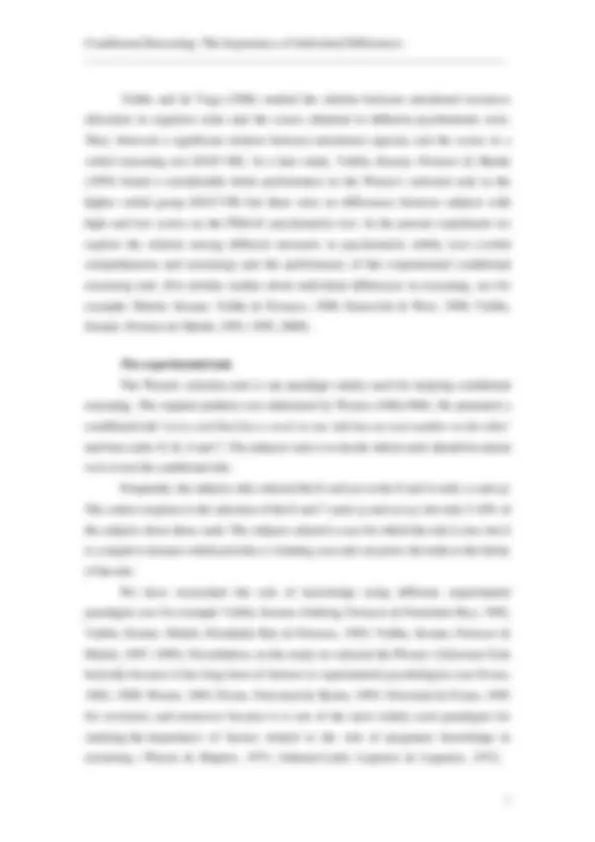
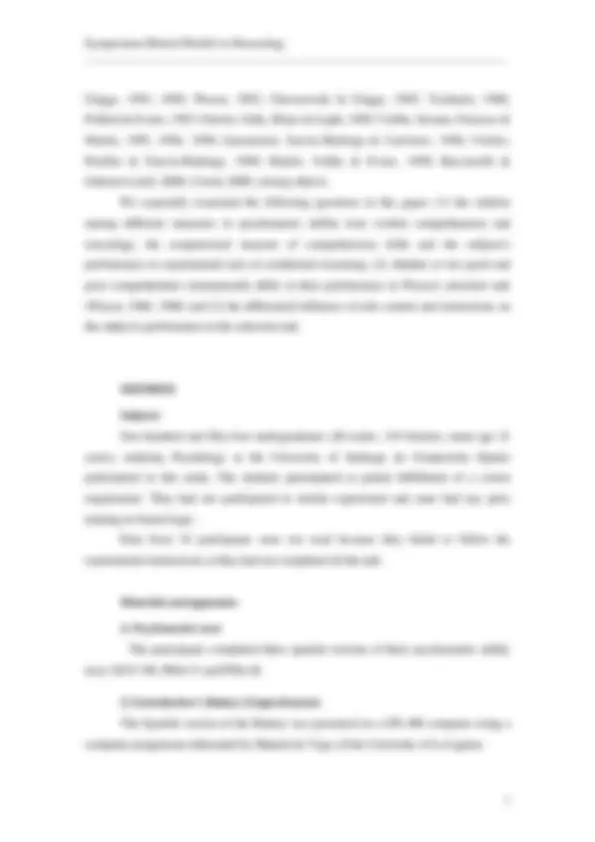
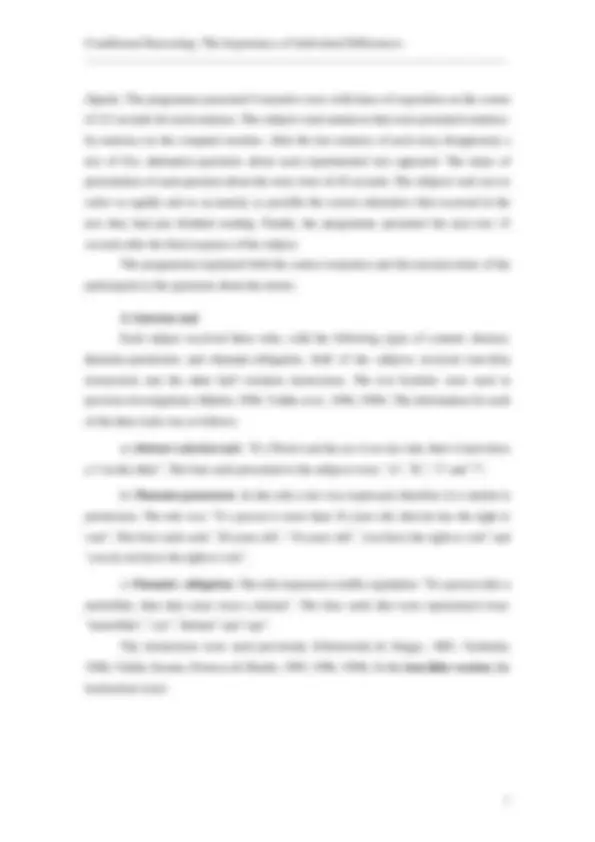
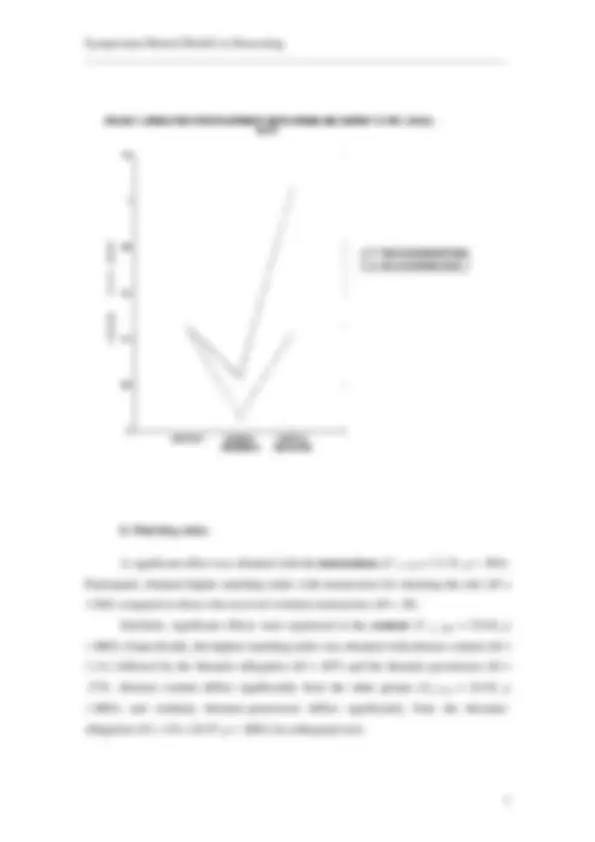
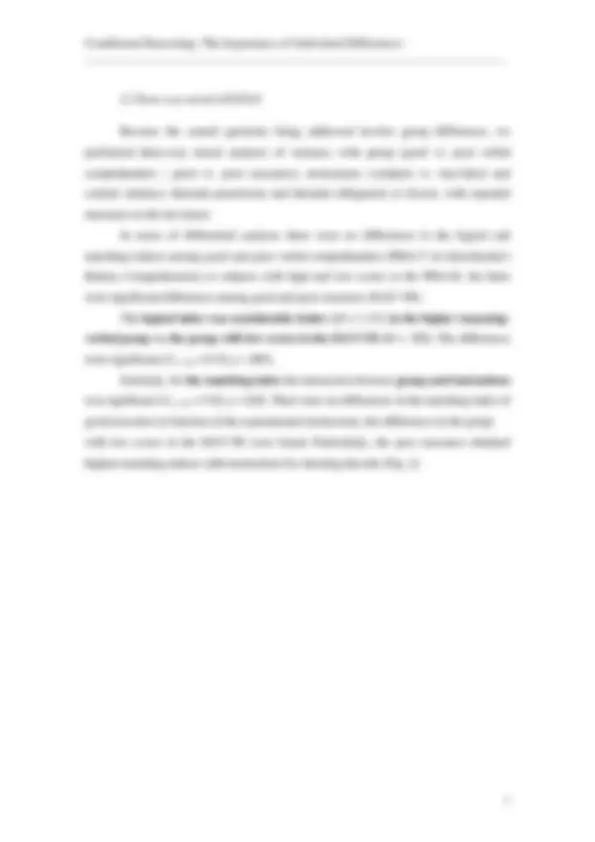
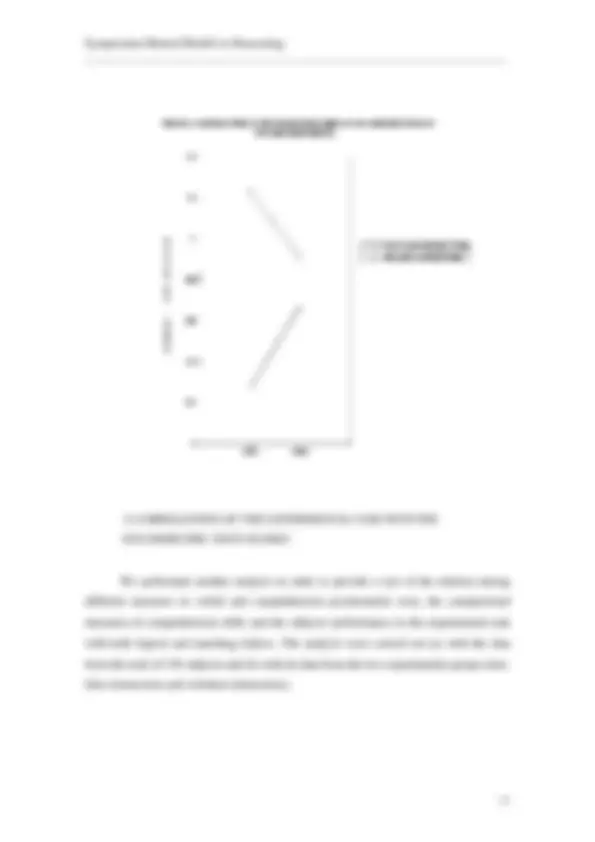
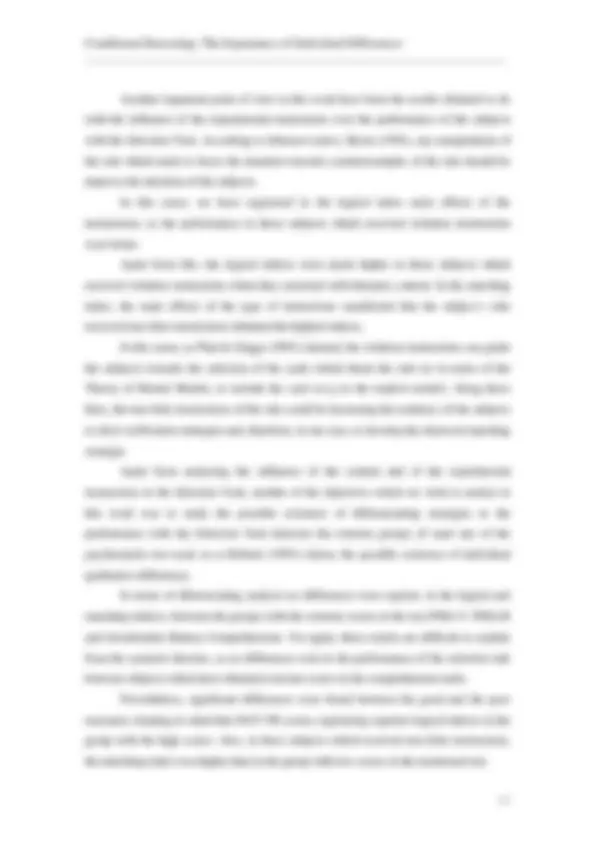
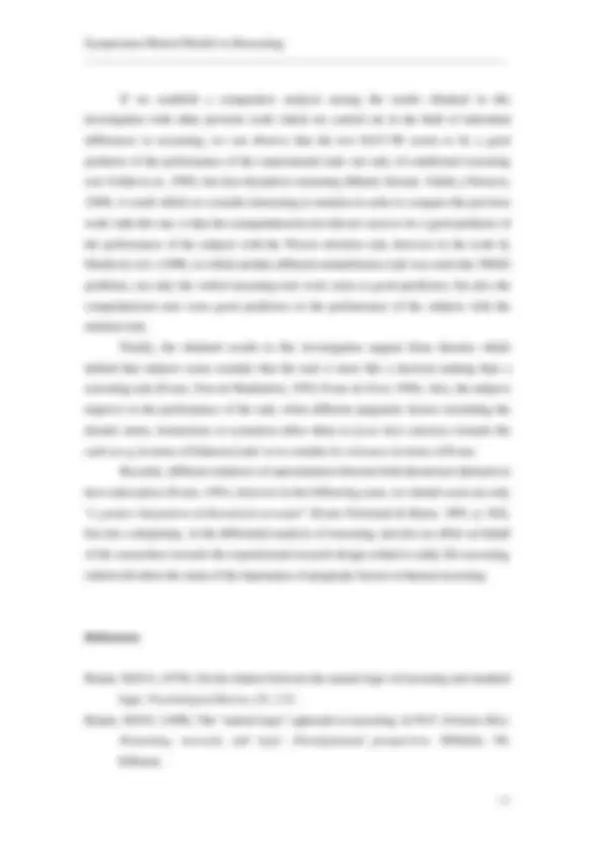
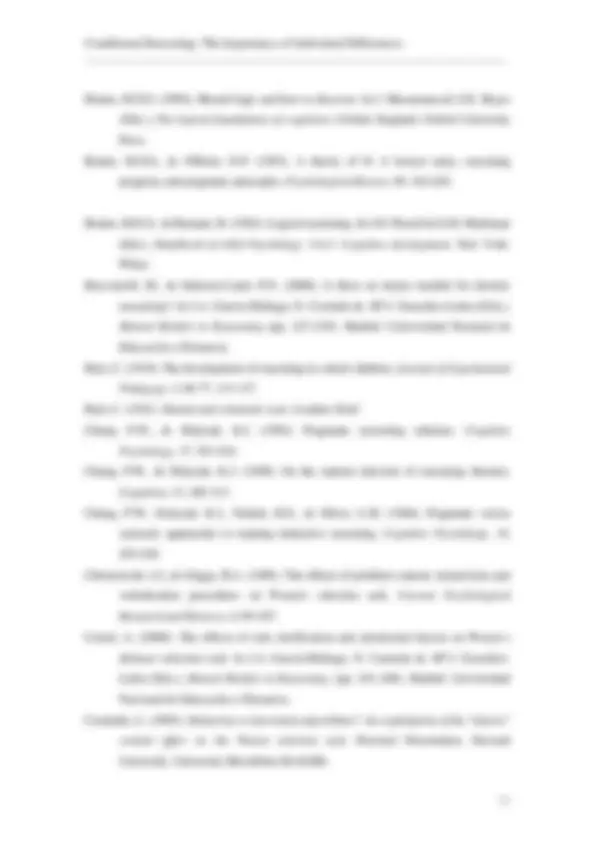
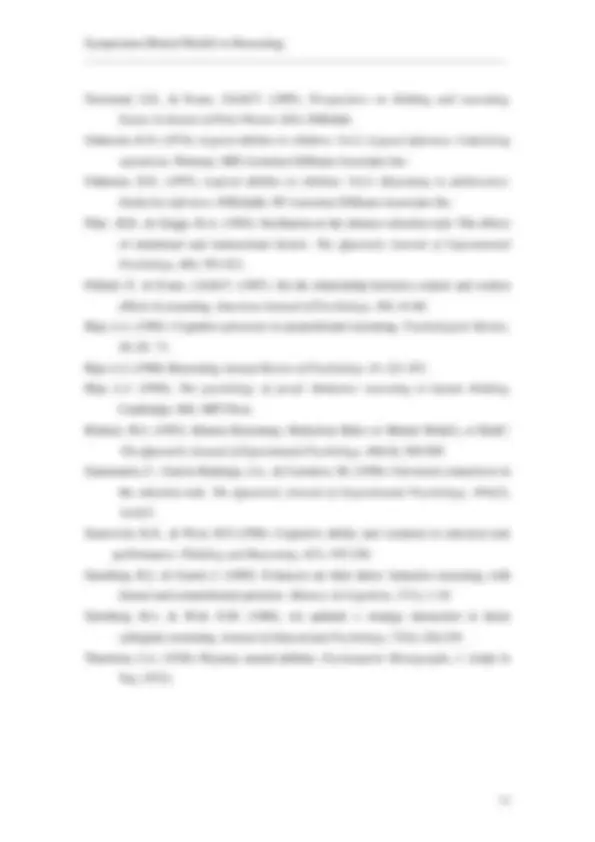
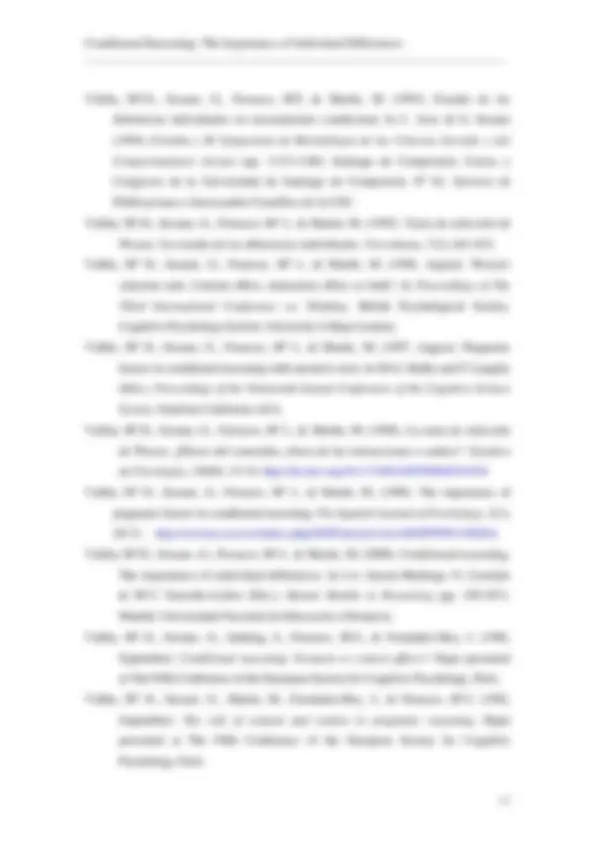
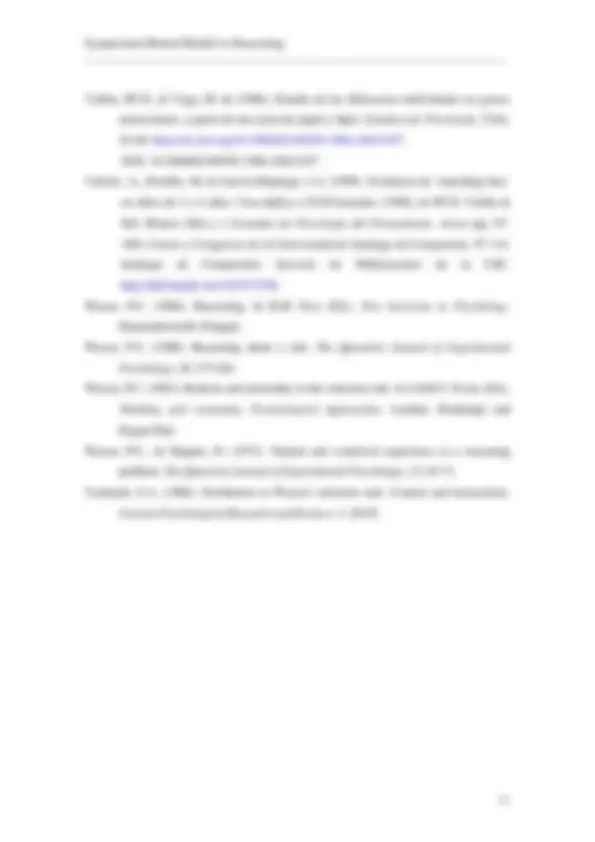


Study with the several resources on Docsity

Earn points by helping other students or get them with a premium plan


Prepare for your exams
Study with the several resources on Docsity

Earn points to download
Earn points by helping other students or get them with a premium plan
Community
Ask the community for help and clear up your study doubts
Discover the best universities in your country according to Docsity users
Free resources
Download our free guides on studying techniques, anxiety management strategies, and thesis advice from Docsity tutors
The relationship between different measures in psychometric ability tests (verbal comprehension and reasoning) and the performance of subjects in a conditional reasoning task. The authors also examine the influence of instructions and rule content on the subject's performance. The study is based on the Wason Selection Task and builds on previous research in the field.
Typology: Exams
1 / 20

This page cannot be seen from the preview
Don't miss anything!













The study of thinking and reasoning is a topic of central interest for economists, anthropologists, logicians, pedagogues and of course for psychologists. A central problem in the experimental investigation in Psychology is to describe how people think and reason deductively and inductively. There are three fundamental theoretical approaches to deductive reasoning in the Cognitive Psychology: mental logic, mental models and pragmatic schemas (see Evans, Newstead & Byrne, 1993, for a detailed review). There are several proponents of a universal mental logic (Inhelder & Piaget, 1958) or natural logics (Braine, 1978, 1990, 1994; Braine & O´Brien, 1991; Braine & Rumain, 1983; Osherson, 1974, 1975; Rips, 1983, 1990, 1994). Other authors propose that reasoning is based on construction and evaluation of mental models (Johnson-Laird, 1983; Johnson-Laird & Byrne, 1991). A third approach asserts that reasoning is not based on general inference rules and assumes that people have domain-specific reasoning mechanisms such as pragmatic reasoning schemas inductively acquired (Cheng & Holyoak, 1985, 1989; Cheng, Holyoak, Nisbett & Oliver, 1986; Holyoak & Cheng, 1995) or innates procedures for identify potential deviations from social contracts (Cosmides 1985, 1989; Cosmides & Tooby, 1992)
***** An extended version of this paper has been published in the chapter: “Conditional reasoning: The importance of individual differences”, of the book: Mental Models in Reasoning , J.A. García-Madruga, N. Carriedo and Mª.J. González-Labra (2000). This book is a collection of the papers presented at the “Symposium on Mental Models in Reasoning”, which took place in Madrid in November of 1998. This occasion enabled the Spanish experts in reasoning to meet with some of their European colleagues with the common aim to celebrate the award by the Universidad Nacional de Educación a Distancia (UNED) of an “honoris causa” doctorate degree to Phil Johnson- Laird (p.11).
Symposium Mental Models in Reasoning
Psychometrics studies the thinking from a different perspective. The central interest for the researchers in Psychometrics is not the understanding of underlying cognitive processes and mental representations but the study of the individual differences in these mental processes. However, despite the differences between these two approaches to the study of human reasoning the categorical syllogisms and linear syllogisms were included on early intelligence tests (Burt, 1919, 1921; Thurstone, 1938; Guilford, 1959). Moreover, in the past decades there is a novel and comparatively neglected field: the study of qualitative and quantitative differences in reasoning. Roberts (1993, p. 575) suggested that: "The problem of individual differences is as follows: if a theory of reasoning is being proposed that is intended to describe the processes used by all people for all reasoning tasks, then what is the status of this theory if it is subsequently found that not all people are using the same processes? ." Galotti, Baron & Sabini (1986) examined the correlates of reasoning ability on a syllogistic reasoning task. They found evidence for the use of both models and rules of reasoning. In a previous work Sternberg and Weil (1980) found individual differences in reasoning strategies (a mental model strategy, a deduction rule strategy and a mixture of both) in the resolution of experimental tasks that involve linear syllogisms. Alternatively, Sternberg and Gastel (1989) investigated information processing during the solution of inductive reasoning problems (analogies, classifications and series completions) and also administred five psychometric tests to each subject. They show correlations between experimental tasks and psychometric tests. These correlations address two principal questions. First, are scores on the experimental tasks related to scores on the psychometric tests?. Second, do the correlations with the reasoning tests differ from those with verbal/perceptual factor?. It was found that the correlations of the experimental task with the reasoning tasks are higher than those with verbal/perceptual tasks. Thus, "the experimental tasks do appear to tap abilities related to those tapped by the psychometric tests" (p. 8). Despite the importance of conditional reasoning in daily life, the study of qualitative individual differences has not become a central focus in cognitive or psychometric studies. There is no nearly previous experimental research about this issue.
Symposium Mental Models in Reasoning
Griggs, 1983, 1989; Wason, 1983; Chrostowski & Griggs, 1985; Yachanin, 1986; Pollard & Evans, 1987; Girotto, Gilly, Blaye & Light, 1989; Valiña, Seoane, Ferraces & Martín, 1995, 1996, 1998; Santamaría, García-Madruga & Carretero, 1996; Veleiro, Peralbo & García-Madruga, 1998; Martín, Valiña & Evans, 1999; Bucciarelli & Johnson-Laird, 2000; Corral, 2000, among others). We especially examined the following questions in this paper: (1) the relation among different measures in psychometric ability tests (verbal comprehension and reasoning), the computerised measure of comprehension skills and the subjects's performance in experimental task of conditional reasoning, (2) whether or not good and poor comprehenders sistematically differ in their performance in Wason's selection task (Wason, 1966, 1968) and (3) the differential influence of rule content and instructions on the subject's performance in the selection task.
Subjects One hundred and fifty-four undergraduates (20 males, 134 females; mean age 21 years), studying Psychology at the University of Santiago de Compostela (Spain) participated in this study. The students participated as partial fulfillment of a course requirement. They had not participated in similar experiment and none had any prior training in formal logic. Data from 18 participants were not used because they failed to follow the experimental instructions or they had not completed all the task.
**_Materials and apparatus
2) Gernsbacher's Battery Comprehension The Spanish version of the Battery was presented on a DX-486 computer using a computer programme elaborated by Manuel de Vega, of the University of La Laguna
Conditional Reasoning: The Importance of Individual Differences
(Spain). The programme presented 4 narrative texts with times of exposition on the screen of 3,5 seconds for each sentence. The subjects read sentences that were presented sentence- by-sentence on the computer monitor. After the last sentence of each story disappeared, a test of five alternative-questions about each experimental text appeared. The times of presentation of each question about the story were of 20 seconds. The subjects' task was to select as rapidly and as accurately as possible the correct alternative that occurred in the text they had just finished reading. Finally, the programme presented the next text 15 seconds after the final response of the subject. The programme registered both the correct responses and the reaction times of the participants to the questions about the stories.
3) Selection task Each subject received three rules, with the following types of content: abstract, thematic-permission and thematic-obligation. Half of the subjects received true-false instructions and the other half violation instructions. The test booklets were used in previous investigations (Martín, 1996; Valiña et al., 1996, 1998). The information for each of the three tasks was as follows:
a) Abstract selection task. "If a Wasit card has an A on one side, then it must have a 3 on the other". The four cards presented to the subjects were: "A", "K", "3" and "7".
b) Thematic-permission. In this rule a law was expressed; therefore it is similar to permission. The rule was: "If a person is more than 18 years old, then he has the right to vote". The four cards said: "20 years old", "16 years old", "you have the right to vote" and "you do not have the right to vote".
c) Thematic- obligation. The rule expressed a traffic regulation: "If a person rides a motorbike, then they must wear a helmet". The four cards that were represented were: "motorbike", "car", "helmet" and "cap". The instructions were used previously (Chrotowski & Griggs, 1985; Yachanin, 1986; Valiña, Seoane, Ferraces & Martín, 1995, 1996, 1998). In the true-false version , the instructions were:
Conditional Reasoning: The Importance of Individual Differences
sistematically differ in their performance in Wason's selection task, and finally we performed analysis in order to provide a test of the relation among different measures in psychometric ability tests (verbal comprehension and reasoning), the computerised measure of comprehension skills and the subjects' performance in the experimental task of conditional reasoning.
1) ANOVAS The logical and matching indices were calculated for each of the three tasks. Both indices vary between +2 and -2, according to Pollard and Evans (1987). In the logical index the p or not-q selection gave a mark of +1 and the not-p or q selection gave -1. In the matching index the p or q selection gave a mark of +1 and with -1 the not-p or not-q selection. ANOVAS 2 x 3 ( instructions x content) were made for each type of index, with the data from the 136 participants.
a) Logical index For the logical index the principal effects of the content ( F (1.82; 244.52)= 21.61; p <.0001; = .912) and the instructions ( F (1, 134) = 6.59; p <.011) were registered. In the thematic-obligation higher logical indices were obtained ( M = .765), followed by the abstract version of the task ( M = .449) and the thematic-permission ( M = .154). Similarly, the logical indices were higher in those subjects who received violation instructions ( M = .87) compared with those who received true-false instructions ( M = .31). Significant interactive effects have also been registered for instructions x content ( F (1.82; 244.52) = 6.32; p <.003; = .912). In the thematic-obligation task higher indices were obtained in those subjects who received violation instructions (Fig. 1).
Symposium Mental Models in Reasoning
b) Matching index
A significant effect was obtained with the instructions ( F (^) (1, 134) = 11.31; p < .001). Participants obtained higher matching index with instructions for checking the rule ( M = 1.042) compared to those who received violation instructions ( M = .58). Similarly, significant effects were registered in the content ( F (^) (2, 268) = 25.64; p <.0001). Especifically, the highest matching index was obtained with abstract content ( M = 1.11), followed by the thematic-obligation ( M = .897) and the thematic-permission ( M = .375). Abstract content differs significantly from the other groups ( F (1,134) = 24.42; p <.0001) and similarly thematic-permission differs significantly from the thematic- obligation ( F (1, 134 = 26.97; p < .0001) by orthogonal tests.
Symposium Mental Models in Reasoning
We performed another analysis in order to provide a test of the relation among different measures in verbal and comprehension psychometric tests, the computerised measures of comprehension skills and the subjects' performance in the experimental task with both logical and matching indices. The analysis were carried out (a) with the data from the total of 136 subjects and (b) with de data from the two experimental groups (true- false instructions and violation instructions).
Conditional Reasoning: The Importance of Individual Differences
The results show for the total sample (N = 136) that: (a) the scores of the DAT-VR are related with the performance in Wason's selection task with the abstract content (r = .317; p = .0001) and with the thematic-permission (r = .2656 ; p = .002) in terms of logical index and (b) there is a significant relation between scores in the DAT-VR psychometric test and the computerised measures of Gernsbacher's Battery Comprehension (r = .1663; p = .05). With the true-false intructions (N = 63) there was found a significant relation between scores in the DAT-VR and the logical index (r = .3524; p = .005) and the matching index (r = - .3779; p = .002) with the abstract content. There was also a significant relation between measures in the Gernsbacher's Battery Comprehension and the logical index for this abstract content (r = .2862; p = .023). With the violation instructions (N = 73) there was a significant relation between measures in the DAT-VR and the logical index for the abstract content (r = .2939; p = .012) and the thematic-permission content ( r = .4316; p = .0001).
The results obtained in this work support the influence of the thematic factors about the ability of the subjects when they performed the Selection Task. However, this facilitating effect of the thematic content does not seem to be as simple as pointed out in previous works. In fact, only when the subjects were presented with thematic rules which expressed an obligation, did they register logical indices superior to abstract ones; nevertheless, when they reasoned with thematic rules which expressed a permission, the registered logical indices were inferior to the formal version of the task. It is difficult to explain this result from formal theories which defend that the reasoning of the subjects is based on sintactic rules. Neither does the Theory of Pragmatic Schemas (Cheng & Holyoak, 1985, 1989; Cheng et al., 1986; Holyoak & Cheng, 1995), allow us to explain the differences in the performance between the two thematic versions of the tasks. However, from the Theory of Mental Models (Johnson-Laird, 1983; Johnson-Laird & Byrne, 1991), to the Heuristic-Analytic theory of Evans (1984, 1989) can the empirical results of this investigation be explained.
Conditional Reasoning: The Importance of Individual Differences
Another important point of view in this work have been the results obtained to do with the influence of the experimental instructions over the performance of the subjects with the Selection Task. According to Johnson-Laird y Byrne (1992), any manipulation of the rule which tends to focus the attention towards counterexamples of the rule should be improve the attention of the subjects. In this sense, we have registered in the logical index main effects of the instructions, as the performance in those subjects which received violation instructions were better. Apart from this, the logical indices were much higher in those subjects which received violation instructions when they reasoned with thematic content. In the matching index, the main effects of the type of instructions manifested that the subject´s who received true-false instructions obtained the highest indices. In this sense, as Platt & Griggs (1993) claimed, the violation instructions can guide the subjects towards the selection of the cards which break the rule (or in terms of the Theory of Mental Models, to include the card not-q in the explicit model). Along these lines, the true-false instructions of the rule could be increasing the tendency of the subjects to elicit verification strategies and, therefore, in our case, to develop the observed matching strategie. Apart from analyzing the influence of the content and of the experimental instructions in the Selection Task, another of the objectives which we wish to analize in this work was to study the possible existence of differenciating strategies in the performance with the Selection Task between the extreme groups of each one of the psychometric test used, or as Roberts (1993) claims, the possible existence of individual qualitative differences. In terms of diferenciating analysis no differences were register, in the logical and matching indices, between the groups with the extreme scores in the test PMA-V, PMA-R and Gernsbacher Battery Comprehension. Yet again, these results are difficult to explain from the syntactic theories, as no differences exist in the performance of the selection task between subjects which have obtained extreme scores in the comprehension tasks. Nevertheless, significant diffreences were found between the good and the poor reasoners, keeping in mind that DAT-VR scores, registering superior logical indices in the group with the high scores. Also, in those subjects which received true-false instructions, the matching index was higher than in the group with low scores in the mentioned test.
Symposium Mental Models in Reasoning
If we establish a comparative analysis among the results obtained in this investigation with other previous work which we carried out in the field of individual differences in reasoning, we can observe that the test DAT-VR seems to be a good predictor of the performance of the experimental tasks not only of conditional reasoning (see Valiña et al., 1995), but also disyuntive reasoning (Martín, Seoane, Valiña y Ferraces, 1998). A result which we consider interesting to mention in order to compare this previous work with this one, is that the comnprehension test did not seem to be a good predictor of the performance of the subjects with the Wason selection task; however in the work by Martín & cols. (1998), in which another different metainference task was used (the THOG problem), not only the verbal reasoning tests were seem as good predictors, but also the comprehension tests were good predictors in the performance of the subjects with the mention task. Finally, the obtained results in this investigation support those theories which defend that subjects seem consider that the task is more like a decision making than a reasoning task (Evans, Over & Manktelow, 1993; Evans & Over, 1996). Also, the subjects improve in the performance of the task, when different pragmatic factors (including the deontic terms, instructions or scenarios) allow them to focus their attention towards the card not-q, in terms of Johnson-Laird or to consider its relevance in terms of Evans. Recently, different tentatives of aproximation between both theoretical alternatives have taken place (Evans, 1991), however in the folllowing years, we should assist not only “ a greater integration of theoretical accounts ” (Evans Newstead & Byrne, 1993, p. 282), but also a deepening in the differential analysis of reasoning, and also an effort on behalf of the researchers towards the experimental research design related to daily life reasoning, which will allow the study of the importance of pragmatic factors in human reasoning.
References
Braine, M.D.S. (1978). On the relation between the natural logic of reasoning and standard logic. Psychological Review , 85 , 1-21. Braine, M.D.S. (1990). The "natural logic" approach to reasoning. In W.F. Overton (Ed.), Reasoning, neccesity and logic: Developmental perspectives. Hillsdale, NJ: Erlbaum.
Symposium Mental Models in Reasoning
Cosmides, L. (1989). The logic of social exchange: Has natural selection shaped how humans reason?. Studies with the Wason selection task. Cognition , 31 , 187-276. Cosmides, L., & Tooby, J. (1992). Cognitive adaptations for social exchange. In J.H. Barkow, L. Cosmides & J. Tooby (Eds.), The adapted mind. Oxford: Oxford University Press. Evans, J.St.B.T. (1982). The psychology of deductive reasoning. London: Routledge and Kegan Paul. Evans, J.St.B.T. (1984). Heuristic and analytic processes in reasoning. British Journal of Psychology , 75 , 451-468. Evans, J.St.B.T. (1989). Bias in human reasoning: Causes and consequences. Hove, UK: Lawrence Erlbaum Associates Ltd. Evans, J.St.B.T. (1991). Theories of human reasoning: The fragmented state of the art. Theory and Psychology , 1 , 83-105. Evans, J.St.B.T., Newstead, S.E., & Byrne, R.M.J. (1993). Human reasoning: The Psychology of deduction. Hove, UK: Lawrence Erlbaum Associates Ltd. Evans, J.St.B.T., & Over, D.E. (1996). Rationalily and reasoning. Essays in Cognitive Psychology. UK: Psychology Press. Evans, J.St.B.T., Over, D.E., & Manktelow, K.I. (1993). Reasoning, decision making, and rationality. Cognition , 49 , 165-187. Galotti, K.M., Baron, J., & Sabini, J. (1986). Individual differences in syllogistic reasoning: Deduction rules or mental models?. Journal of Experimental Psychology: General , 115 , 16-25. García-Madruga, J.A., Carriedo, N., & González-Labra, Mª.J. (Eds.) (2000). Mental Models in Reasoning. Madrid: Universidad Nacional de Educación a Distancia. Girotto, V., Gilly, M., Blaye, A., & Light, P. (1989). Children´s performance in the selection task: Plausibility and familiarity. British Journal of Psychology , 80 , 79-
Griggs, R.A. (1983). The role of problem content in the selection task and THOG problem. In J. St.B.T. Evans (Ed.), Thinking and Reasoning: Psychological Approaches. London: Routledge and Kegan Paul. Griggs, R.A. (1989). To "see" or not to "see": That is the selection task. The Quarterly Journal of Experimental Psychology , 41A , 517-529. Guilford, J.P. (1959). Three faces of intellect. American Psychologist , 14 , 469-479.
Conditional Reasoning: The Importance of Individual Differences
Holyoak, K.J., & Cheng, P.W. (1995). Pragmatic reasoning about human voluntary action: Evidence from Wason´s selection task. In S.E. Newstead y J.St.B.T. Evans (Eds.), Perspectives on thinking and reasoning. Essays in honour of Peter Wason (pp. 67- 89). Hove: Lawrence Erlbaum Associates, Inc. Inhelder, B., & Piaget, J. (1958). The growth of logical thinking. New York: Basic Books. Johnson-Laird, P.N. (1983). Mental models. Towards a cognitive science of language, inference and consciousness. Cambridge, England: Cambridge University Press. Johnson-Laird, P.N., & Byrne, R.M.J. (1991). Deduction. Hove, U.K.: Lawrence Erlbaum Associates Johnson-Laird, P.N., & Byrne, R.M.J. (1992). Modal reasoning, models, and Manktelow and Over. Cognition , 43 , 173-182. Johnson-Laird, P.N., Legrenzi, P., & Legrenzi, S. (1972). Reasoning and a sense of reality. British Journal of Psychology , 63 , 336-400. Manktelow, K.I., & Over, D.E. (1991). Social roles and utilities in reasoning with deontic conditionals. Cognition , 39 , 85-105. Martín, M. (1996). Una exploración del razonamiento cotidiano: Importancia del conocimiento en inferencia condicional. Unpublished doctoral dissertation. University of Santiago de Compostela, Spain. Martín, M., Carretero, M., Asensio, M., & Valiña, Mª.D. (1998). Importancia de los factores pragmáticos en inferencia condicional: Un estudio cronométrico. En Mª.D. Valiña y M.J. Blanco (Eds.), I Jornadas de Psicología del Pensamiento. Actas (pp. 79-96). Cursos y Congresos de la Universidad de Santiago de Compostela. Nº 114. Santiago de Compostela: Servicio de Publicaciones de la USC. http://hdl.handle.net/10347/3766. Martín, M., Seoane, G., Valiña, Mª.D., & Ferraces, Mª.J. (1998, July). La importancia de las diferencias individuales en razonamiento disyuntivo. Proceedings of II Congreso Iberoamericano de Psicología. Madrid: Alpe Ceter. [Published in CD- Rom]. Martín, M., Valiña, M.D., & Evans, J.St.B.T. (1999). The role of scenario, deontic conditionals and problem content in Wason´s selection task. European Conference on Cognitive Science. In S. Bagnara (Ed.), Proceedings of the European Conference on Cognitive Science (pp. 259-264). Siena, Italy.
Conditional Reasoning: The Importance of Individual Differences
Valiña, Mª.D., Seoane, G., Ferraces, MªJ, & Martín, M. (1993). Estudio de las diferencias individuales en razonamiento condicional. In C. Arce & G. Seoane (1994) (Coords .). III Symposium de Metodología de las Ciencias Sociales y del Comportamiento (Actas) (pp. 1133-1140). Santiago de Compostela: Cursos y Congresos de la Universidad de Santiago de Compostela. Nº 82. Servicio de Publicaciones e Intercambio Científico de la USC. Valiña, Mª.D., Seoane, G., Ferraces, Mª J., & Martín, M. (1995). Tarea de selección de Wason: Un estudio de las diferencias individuales. Psicothema , 7 (3), 641-653. Valiña, Mª D., Seoane, G., Ferraces, Mª J., & Martín, M. (1996, August). Wason's selection task: Content effect, instruction effect or both?. In Proceedings of The Third International Conference on Thinking. British Psychological Society. Cognitive Psychology Section. University College London. Valiña, Mª D., Seoane, G., Ferraces, Mª J., & Martín, M. (1997, August). Pragmatic factors in conditional reasoning with narrative texts. In M.G. Shafto and P. Langley (Eds.), Proceedings of the Nineteenth Annual Conference of the Cognitive Science Society. Stanford, California: LEA. Valiña, Mª.D., Seoane, G., Ferraces, Mª J., & Martín, M. (1998). La tarea de selección de Wason: ¿Efecto del contenido, efecto de las instrucciones o ambos? Estudios de Psicología , 19 (60), 15-34. http://dx.doi.org/10.1174/ Valiña, Mª D., Seoane, G., Ferraces, Mª J., & Martín, M. (1999). The importance of pragmatic factors in conditional reasoning. The Spanish Journal of Psychology, 2 (1), 20-31. http://revistas.ucm.es/index.php/SJOP/article/view/SJOP9999110020A Valiña, Mª.D., Seoane, G., Ferraces, Mª.J., & Martín, M. (2000). Conditional reasoning: The importance of individual differences. In J.A. García-Madruga, N. Carriedo & Mª.J. González-Labra (Eds.), Mental Models in Reasoning (pp. 249-267). Madrid: Universidad Nacional de Educación a Distancia. Valiña, Mª D., Seoane, G., Gehring, S., Ferraces, Mª.J., & Fernández-Rey, J. (1992, September). Conditional reasoning: Scenario or context effects?. Paper presented at The Fifth Conference of the European Society for Cognitive Psychology, Paris. Valiña, Mª D., Seoane, G., Martín, M., Fernández-Rey, J., & Ferraces, Mª.J. (1992, September). The role of content and context in pragmatic reasoning. Paper presented at The Fifth Conference of the European Society for Cognitive Psychology, Paris.
Symposium Mental Models in Reasoning
Valiña, Mª.D., & Vega, M. de (1986). Estudio de las diferencias individuales en gastos atencionales, a partir de una tarea de papel y lápiz. Estudios de Psicología , 7 (26), 29-40. http://dx.doi.org/10.1080/02109395.1986.10821457. DOI: 10.1080/02109395.1986.10821457. Veleiro, A., Peralbo, M, & García-Madruga, J.A. (1998). Evidencia de `matching bias´ en niños de 3 y 4 años: Una réplica a D.D.Cummins (1996). In Mª.D. Valiña & M.J. Blanco (Eds.), I Jornadas de Psicología del Pensamiento. Actas (pp. 97- 109). Cursos y Congresos de la Universidad de Santiago de Compostela. Nº 114. Santiago de Compostela: Servicio de Publicaciones de la USC. http://hdl.handle.net/10347/ Wason, P.C. (1966). Reasoning. In B.M. Foss (Ed.), New horizonts in Psychology. Harmondsworth: Penguin. Wason, P.C. (1968). Reasoning about a rule. The Quarterly Journal of Experimental Psychology , 20 , 273-281. Wason, P.C. (1983). Realism and rationality in the selection task. In J.St.B.T. Evans (Ed.), Thinking and reasoning: Psychological Approaches. London: Routledge and Kegan Paul. Wason, P.C., & Shapiro, D. (1971). Natural and contrived experience in a reasoning problem. The Quarterly Journal of Experimental Psychology , 23 , 63-71. Yachanin, S.A. (1986). Facilitation in Wason's selection task: Content and instructions. Current Psychological Research and Reviews , 5 , 20-29.